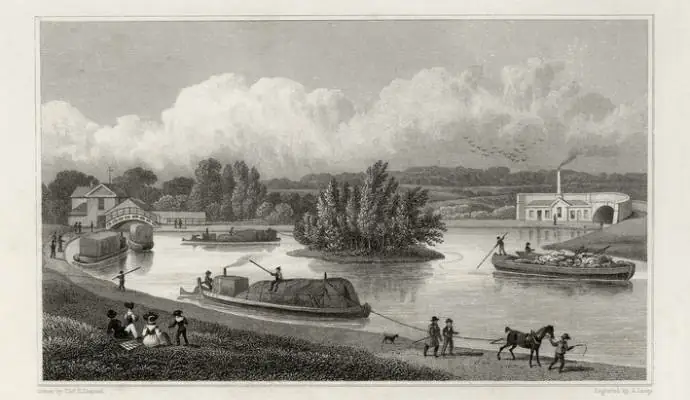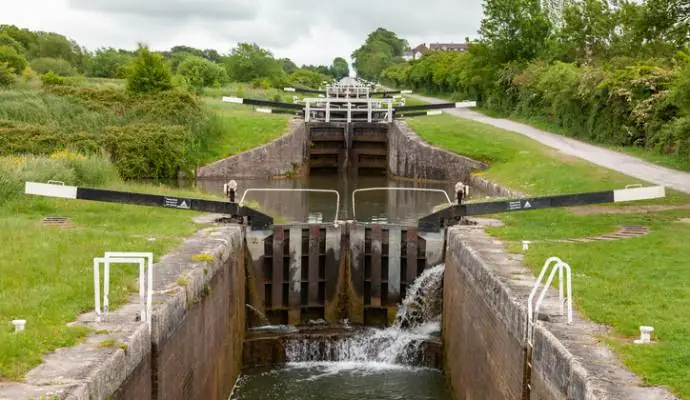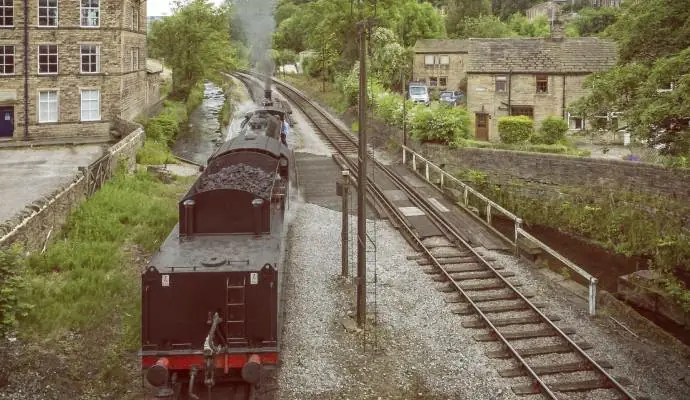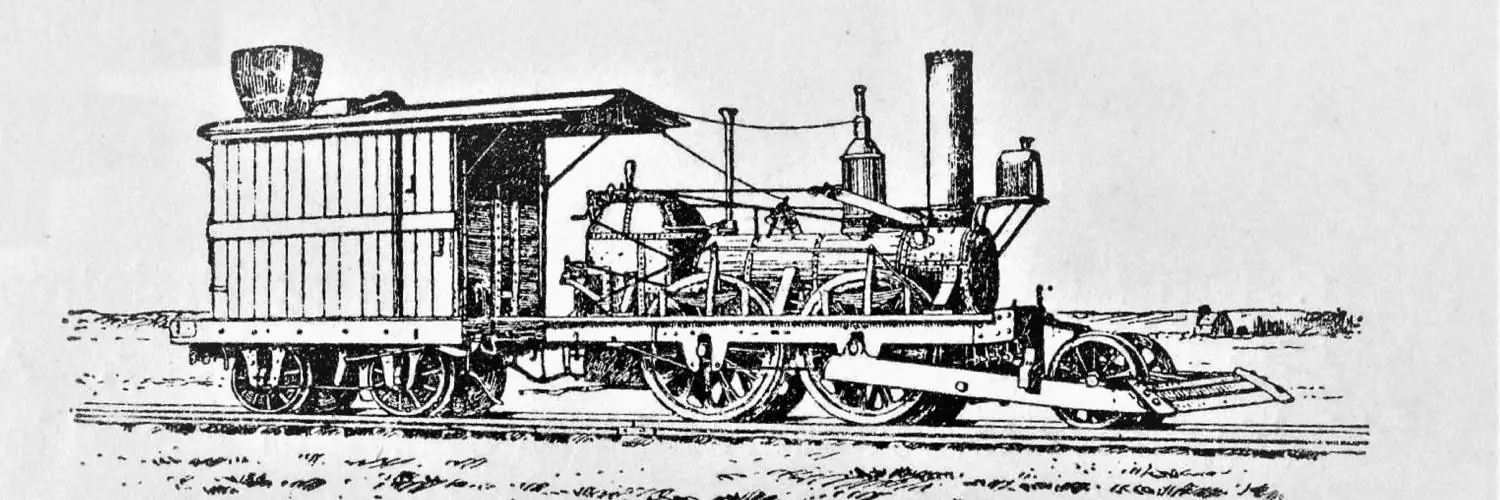As we move towards the Industrial Revolution which started to gather steam (pun fully intended) from the 1750’s are we any closer to a reliable same day courier service across the UK? If you can recall our first article on the history of Couriers History Through The Ages, it reckoned that the Romans could travel by a series of fast horses and riders in ten hours from York to London. This did not improve one bit over the next 1300 years. In fact, travel times became worse with poorly maintained roads.
A same day courier service by canal
But it wasn’t improved roads that saw delivery times get faster at first. We need to look at canals and railways. It’s not until the very end of the 19th century with the production of the first commercial vehicles that we can glimpse the true first fast couriers.

Canal building in the UK started in earnest at a time when Britain was bursting with trade, industry and commerce. Manufacturing had already begun to change, from local craftsmen working in cottage industries to the mills and factories where goods could be mass produced by machines.

Good communications became vital in order to move raw materials to the factories, and from those same factories, the finished products to the consumer. And not just to consumers in Britain, but throughout the expanding British Empire. Roads were also being constructed and improved, but they couldn’t easily handle heavy and bulky materials like coal and steel, or delicate and fragile materials like pottery. The roads still relied upon horse drawn power which we know limits travel to 10 to 15 miles a day. Roads could not compete with water where one horse could pull fifty tons of cargo in a boat.
At this time there were over a thousand miles of navigable rivers in Britain, but the problem was, they didn’t go to the right places anymore; the industrial north and the Midlands were not connected with the consumer-based south, nor the ports through which their goods could be exported. Not unusual and still a problem in the 21st century, think HS2 (High Speed 2)!
The Bridgwater Canal, completed in 1776, took coal from Worsley directly into Manchester cutting in half the cost of coal for the burgeoning factories. Meanwhile other regions of England like the mill towns and cities of Lancashire and Yorkshire, the Staffordshire Potteries and the Black Country in the West Midlands were developed and became wealthy as a result of their canal systems.
It was not until 1793 that an Act was passed to authorise the construction of the Grand Junction Canal from Braunston on the Oxford Canal to Brentford on the River Thames, just west of London. London itself was not connected directly to the national canal network until 1801.
An amazing canal fact
Horse drawn narrow boats in the Midlands lasted into the 1950s whilst horses pulling big barges, with their bigger payloads, were still at work on the Regents Canal in London until the 1960s. Two hundred years is surely not a bad history for one virtually unaltered form of transport?

So for a few decades, deliveries by water were the most reliable and fastest way. Some of these vessels could move around nine miles an hour but remember the canals were more or less as the crow files so the 36 miles between Manchester and Liverpool could easily be done in four hours. Therefore as long as the delivery and collection were on a canal route a package leaving at 7am could easily travel 100 miles by 7pm.

The same day courier service by railway
The railway network flourished between 1830 and 1870. By 1852 there were over 7,000 miles of rail track in England and Scotland, and every significant centre could rely on rail communication. Britain’s railways transformed the landscape both physically and culturally, producing new opportunities for commerce and travel, and fuelling industrial and economic expansion. Goods could be transported at unprecedented rates.

Major cities, such as Birmingham, Liverpool, Manchester and Bristol were now interconnected. Until the creation of the railway, the fastest speed known to man had been that of a galloping horse. Now, an express train could reach speeds of 80 miles an hour.
Newspapers printed in London in the early hours could be loaded on a train to be sold that morning ‘hot from the press’ in the provinces.
Fresh produce such as milk or meat could be rushed from rural producers to city consumers on a daily basis. It was even possible to send a letter or small parcel first thing in the morning and have a response by midday on the same day.

We are now at a same day courier service in the UK! Yeah! Or are we?
Don’t forget that the courier service was totally reliant on trains. Once the train had arrived at the station it was back to good old horse and cart to plod to the final destination along some very questionable roads; in fact, many of the roads were the original Roman ones!
To truly be a same day courier service we have to wait until 1896 for our first truck and 1903 until vehicles could travel at speeds of up to 20mph legally.
Roads
At the same time that canals and railways flourished Turnpike Trusts were set up to maintain roads. Users had to pay a toll to use the road which was supposed to go directly to road maintenance and improvement. But it was not government controlled and as canals and railways became more popular, the Turnpike Trusts fell by the wayside. But they did ‘pave’ the way for the introduction of the motorised cart at the end of the 19th century.
Here comes our commercial vehicle at last
The very first truck was credited to Gottlieb Daimler in 1896. The truck looked like a cart with an engine and without a drawbar. The engine, called “Phoenix”, was a four-horsepower-strong two-cylinder engine located at the rear. Daimler linked it to the rear axle by means of a belt. There were two helical springs to protect the engine, which was sensitive to vibrations. The vehicle rolled on hard iron wheels. Daimler steered the leaf-sprung front axle by means of a chain. The driver sat up front on the driving seat as with a carriage. The engine was at the rear of the vehicle. The fuel consumption was approximately six litres of petrol per 100 kilometres or 39 mpg. Impressive!
So here we are in modern 1930’s Britain. We have fairly good roads, we have reliable trucks and we can travel comfortably at speeds of 50 to 60mph. How long would it take our courier to get from York to London, just as his Roman ancestor did? The journey would be approximately 5 ½ hours (no motorways yet) on the A1 all done in safety and comfort with no swift horse changes or saddle sore rears!
For all your same day courier service needs, not just in the UK but also Europe; you can give Same Day Couriers Direct a call on 0333 772 1010 to find out more about all the routes we use to cover all your important locations.
